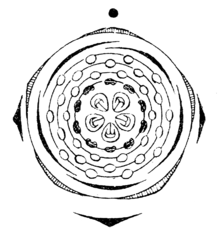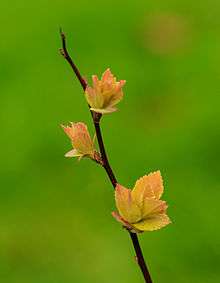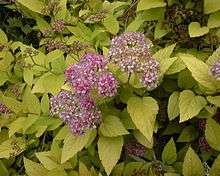Spiraea
| Spiraea | |
|---|---|
 | |
| Spiraea salicifolia Illustration | |
| Scientific classification | |
| Kingdom: | Plantae |
| (unranked): | Angiosperms |
| (unranked): | Eudicots |
| (unranked): | Rosids |
| Order: | Rosales |
| Family: | Rosaceae |
| Subfamily: | Amygdaloideae[1] |
| Genus: | Spiraea L. |
| Species | |
|
About 80-100, see text | |
Spiraea /spaɪˈriːə/,[2] is a genus of about 80 to 100 species[3] of shrubs in the family Rosaceae. They are native to the temperate Northern Hemisphere, with the greatest diversity in eastern Asia.
The genus formerly included the herbaceous species now segregated into the genera Filipendula and Aruncus; recent genetic evidence has shown that Filipendula is only distantly related to Spiraea, belonging in the subfamily Rosoideae.
Description

.jpg)

Spiraea plants are hardy, deciduous-leaved shrubs. The leaves are simple and usually short stalked, and are arranged in a spiralling, alternate fashion. In most species, the leaves are lanceolate (narrowly oval) and about 1 to 4 inches (2.5 to 10.2 cm) long. The leaf margins are usually toothed, occasionally cut or lobed, and rarely smooth. Stipules are absent.
The many small flowers of Spiraea shrubs are clustered together in inflorescences, usually in dense panicles, umbrella-like corymbs, or grape-like clusters. The radial symmetry of each flower is five-fold, with the flowers usually bisexual, rarely unisexual. The flowers have five sepals and five white, pink, or reddish petals that are usually longer than the sepals. Each flower has many (15 to 60) stamens. The fruit is an aggregate of follicles.[3]
Ecology
Spiraea species are used as food plants by the larvae of many Lepidoptera species, including the Brown-tail, the Small Emperor Moth, the Grey Dagger, the Setaceous Hebrew character, and the moth Hypercompe indecisa.
Uses
Horticulture
Many species of Spiraea are used as ornamental plants in temperate climates, particularly for their showy clusters of dense flowers. Some species bloom in the spring, others in midsummer.
The following species, hybrids and cultivars are among those found in cultivation:
|
|
|
Traditional medicine
Spiraea contain salicylates. Acetylsalicylic acid was first isolated from Filipendula ulmaria, a species at the time classified in the genus Spiraea. The word "aspirin" was coined by adding a- (for acetylation) to spirin, from the German Spirsäure, a reference to Spiraea.[5][6][7]
Native American groups had various medicinal uses for local Spiraea species. S. betulifolia was used for abdominal pain and made into a tea.[8] The Blackfoot used S. splendens root in an enema and to treat venereal conditions.[9]
Other
Native Americans found S. douglasii useful for making brooms and hanging seafood to cook.[10]
Species
- Spiraea affinis
- Spiraea alaskaense
- Spiraea alba – narrow-leaved meadowsweet, pale bridewort
- Spiraea albiflora
- Spiraea amoena
- Spiraea arcuata
- Spiraea baldschuanica
- Spiraea bella
- Spiraea betulifolia – white meadowsweet
- Spiraea blumei
- Spiraea calcicola
- Spiraea cana
- Spiraea canescens – Himalayan spiraea
- Spiraea cantoniensis – Reeve's spiraea
- Spiraea chamaedryfolia – elm-leaf spiraea, germander meadowsweet
- Spiraea crenata
- Spiraea decumbens
- Spiraea douglasii – Douglas' spiraea, steeplebush
- Spiraea gemmata
- Spiraea henryi
- Spiraea hypericifolia – Iberian meadowsweet
- Spiraea japonica – Japanese spiraea
- Spiraea latifolia - Broadleaf Meadowsweet
- Spiraea longigemmis
- Spiraea media – Russian spiraea
- Spiraea micrantha
- Spiraea miyabei
- Spiraea mollifolia
- Spiraea nervosa
- Spiraea nipponica
- Spiraea prunifolia – bridal-wreath spiraea
- Spiraea pubescens
- Spiraea rosthornii
- Spiraea salicifolia – bridewort, willowleaf meadowsweet
- Spiraea sargentiana
- Spiraea septentrionalis – northern meadowsweet
- Spiraea splendens – rose meadowsweet
- Spiraea stevenii – beauverd spirea
- Spiraea thunbergii – Thunberg's meadowsweet
- Spiraea tomentosa – hardhack, steeplebush
- Spiraea trichocarpa
- Spiraea trilobata – Asian meadowsweet
- Spiraea veitchii
- Spiraea virginiana – Virginia spiraea
- Spiraea wilsonii
- Spiraea yunnanensis
Formerly placed here
- Spiraea lobata, moved to Filipendula rubra
Hybrids
There are also numerous named hybrids, some occurring naturally in the wild, others bred in gardens, including several important ornamental plants:
- Spiraea × arguta (S. × multiflora × S. thunbergii) – garland spiraea
- Spiraea × billiardii (S. douglasii × S. salicifolia) – Billiard's spiraea
- Spiraea × blanda (S. nervosa × S. cantoniensis)
- Spiraea × brachybotrys (S. canescens × S. douglasii)
- Spiraea × bumalda (S. japonica × S. albiflora)
- Spiraea × cinerea (S. hypericifolia × S. cana)
- Spiraea × conspicua (S. japonica × S. latifolia)
- Spiraea × fontenaysii (S. canescens × S. salicifolia)
- Spiraea × foxii (S. japonica × S. betulifolia)
- Spiraea × gieseleriana (S. cana × S. chamaedryfolia)
- Spiraea × macrothyrsa (S. douglasii × S. latifolia)
- Spiraea × multiflora (S. crenata × S. hypericifolia)
- Spiraea × notha (S. betulifolia × S. latifolia)
- Spiraea × nudiflora (S. chamaedryfolia × S. bella)
- Spiraea × pikoviensis (S. crenata × S. media)
- Spiraea × pyramidata (S. betulifolia × S. douglasii) – pyramid spiraea
- Spiraea × revirescens (S. amoena × S. japonica)
- Spiraea × sanssouciana (S. japonica × S. douglasii)
- Spiraea × schinabeckii (S. chamaedryfolia × S. trilobata)
- Spiraea × semperflorens (S. japonica × S. salicifolia)
- Spiraea × vanhouttei (S. trilobata × S. cantoniensis) – Van Houtte's spiraea
- Spiraea × watsoniana (S. douglasii × S. densiflora)
References
- ↑ Potter, D., et al. (2007). Phylogeny and classification of Rosaceae. Plant Systematics and Evolution 266, 5-43. [Referring to the subfamily by the name "Spiraeoideae"]
- ↑ Sunset Western Garden Book. 1995. 606–07.
- 1 2 Spiraea. Flora of China.
- ↑ RHS A-Z Encyclopedia of Garden Plants. United Kingdom: Dorling Kindersley. 2008. p. 1136. ISBN 1405332964.
- ↑ Scott, D. L. and G. H. Kingsley. Symptomatic Drug Treatment. Chapter 3 In: Inflammatory Arthritis in Clinical Practice (pp. 48-64). Springer London. 2007.
- ↑ Harper, D. aspirin. Online Etymology Dictionary. 2013.
- ↑ Weiss, H. J. (1974). Aspirin – A dangerous drug? JAMA 229(9), 1221-22.
- ↑ Spiraea betulifolia. Native American Ethnobotany. University of Michigan, Dearborn.
- ↑ Spiraea splendens. Native American Ethnobotany. University of Michigan, Dearborn.
- ↑ Spiraea douglasii. Native American Ethnobotany. University of Michigan, Dearborn.
External links
| Wikimedia Commons has media related to Spiraea. |
- GRIN Species Records of Spiraea. Germplasm Resources Information Network (GRIN).
- Spiraea. Integrated Taxonomic Information System (ITIS).
-
 "Spiræa". New International Encyclopedia. 1905.
"Spiræa". New International Encyclopedia. 1905.

